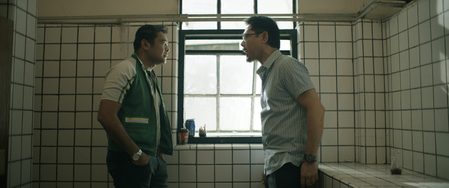SUMMARY
This is AI generated summarization, which may have errors. For context, always refer to the full article.
![[Ilonggo Notes] Putting the spotlight on Ilonggo and regional cinema](https://www.rappler.com/tachyon/2024/04/Screenshot-2024-04-07-at-2.04.59-PM.png)
The month of March was a special one for Iloilo film buffs. From March 19-21, the University of the Philippines Visayas cinematheque and the shops at Atria hosted the National Council for Culture and the Arts (NCCA) flagship film festival, Cinema Rehiyon (16th edition), showing over 50 documentaries, shorts, and full features from filmmakers outside of “Imperial Manila.”
On March 8-9, UP Visayas had a seminar-workshop, open to all disciplines and colleges, on “Film as Pedagogy,” part of a national campaign to use film as a tool for education. Film historian-academic-author-director Nick Deocampo, Iloilo’s pride, was the main resource speaker. And since it was also Women’s Month, the FDCP cinematheque in Iloilo had a series of free screenings of films on women, including the Marilou Diaz-Abaya trilogy: Brutal, Karnal and Moral.
This got me to reminiscing about Ilonggo cinema – those made by Ilonggo and Pananyanon filmmakers, featuring local cast and crew, production, and talents; using our settings and local languages, with stories allowing the POV of locals to surface and predominate.
A truly regional cinema
Cinema Rehiyon, a state-funded film festival first established in 2009, is credited by Katrina Tan for “creating ripples of new cinematic consciousness.” Festival film programming plays a vital role, and Cinema Rehiyon founder Teddy Co’s criteria for selection remains its guiding light: “…films shot or set outside Manila, use of local language, have a director connected to a regional place, and/or contain a regional point of view…”
I managed to catch the opening and closing films; the opener, The Gospel of the Beast, a full feature using Hiligaynon and Karay-a, was shot mainly in Iloilo City. Starring Jensen Magpusao (John Denver Trending) and the veteran Ronnie Lazaro, the film has a predominantly dark tone and explores a descent into the underbelly and origins of evil, as experienced by the young, angelic-faced Magpusao, whose character works at a slaughterhouse, but shifts, albeit uneasily, into savagery, as part of a gang of killers for hire.
The screening was preceded by a conversation with director Sheron Dayoc and producers Sonny Calvento and Arden Rod Condes, moderated by film critic and NCCA Film Committee Vice-Chair Tito Genova Valiente, whose grandparents hail from Arevalo.
The closing film, Ghosts of Kalantiaw (director: Chuck Escasa, 2023) is a documentary set in Batan, Aklan, where a Bornean Datu, Kalantiaw, allegedly governed and propagated an eponymous code of conduct still cited by some history books, and sworn to by many from Batan. Six decades after its “discovery,” it was established that the code was a creation of the feverish imagination of Jose E. Marco, the greatest hoaxer in Philippine history, who is from Negros. The documentary is an unflinching exposition of a post-truth era, where people believe what they wish to believe, regardless of facts staring at them in the face. Its relevance to the return of a political family to the highest position in the country, 35 years after being chased out, cannot be overemphasized.
Iloilo’s hosting of Cinema Rehiyon was highly appreciated. The fully packed program included film screenings, talks, and lectures; town hall meetings; tributes; and the launch of an online film library. Delegate-participants expressed thanks for “…the respect, recognition, and appreciation…. This sets the standard for what Cinema Rehiyon should be…” NCCA film committee Chair Butch Ibañez and its members, FDCP officials, festival director Noel Galon de Leon, deputy director Kyle Fermindoza, and the team of volunteers deserve credit for the successful running of the festival.
Other film festivals in Region VI
Region VI has its share of film festivals. The oldest one is Guimbal town’s Bantayan (watchtower) film festival, celebrating its 20th anniversary in 2024. The Margaha festival in Sagay is now on its fifth year; while Bacolod has Cine Negrense. Bakunawa Fest, an international fantasy genre festival, is on its 11th year, while the CineKasimanwa’ Western Visayas Film Festival, the largest regional film festival in the country, is on its 12th year. The last two festivals were founded by indie director-cinematographer and multidisciplinary artist Elvert Bañares.
The beginnings of cinema in Iloilo were spurred by Iloilo’s own advances in trade and economic development as the “Queen City of the South,” its cosmopolitan character from the mid-19th century onwards, the various Hispano-American influences, and emerging technology of film and cameras. Iloilo was one of the first places in the country where one could watch films; an Englishman, Mr. Bischoff, was the first to show films in Iloilo in 1903. These were short features produced by the film company Cinematographo Pastor and were screened nightly in Bischoff’s bodega in Calle Real.
Mrs. Campbell Dauncey, in An Englishwoman in the Philippines, relates her experiences watching cinematographs (as movies were then called), musical plays, and even visiting Italian opera companies when she lived in Iloilo for nine months in 1904-05. Her deeply racist and condescending views notwithstanding, the book is an often amusing and colorful portrait of a privileged life in Iloilo at the time.
The central business district (CBD) of Iloilo still has buildings from the 1920s that housed theaters. During the heydays of the ’70s and ’80s, before Beta/VHS, DVDs, and mall multiplexes, the CBD had 15-20 movie houses; none are operational today, having been converted into offices, retail spaces, fast food joints, ukay-ukay, and plastic goods outlets.
Iloilo City has two arthouse cinemas, each seating about 100-120 – the UPV cinematheque (Cinema Exmundo) and the FDCP Iloilo cinematheque. Both these theaters have attached galleries. Cinema Exmundo has a formidable collection of publications, rare Hollywood film memorabilia, and autographed film posters – the only one of its kind in the country.
The first all-Ilonggo film, Gina Uhaw Ako, Gina Gutom Ako (I am thirsty, I am hungry), was directed by Quin Baterna and Leonardo Belen, and released in 1977. It starred Susan Henson and Bernard Bonnin and has scenes of the Candelaria procession in Jaro. The film has been restored by the Centre National Du Cinéma Et De L’image Animée (CNC) of the French Ministry of Culture in partnership with the Philippine National Film Archives and the FDCP.
The list of Ilonggo film actors in mainstream Filipino cinema is long – Susan Roces, Rosemarie Sonora, Susan Valdez, Lorli Villanueva, Joel Torre, Edu Manzano, Dingdong Dantes, among others. Negrense directors/scriptwriters Peque Gallaga (Oro, Plata, Mata; Shake, Rattle and Roll; Magic Temple, Sonata), Lawrence Fajardo (Kintsugi, A Hard Day) and Erik Matti (Honor Thy Father, On the Job) have been trailblazers in Philippine cinema, enjoying both commercial and arthouse success. Matti’s films have been selected for Cannes and Venice, two of the best-known film festivals.
While many of those mentioned earlier are household names, it has recently come to light that one of the pioneers of the Philippine cinema industry is an Ilongga: Isabel Acuña de Nepomuceno. Film studies researcher Nadi Tofighian cites her as an example of how women have been historically excluded from the annals of film history. Acuña was vice president of Malayan Films, the leading film production company in the country in the 1930s, and was responsible for various production processes – from casting, styling, coaching, costumes, make-up, etc. as the “right and left hand” of the director Jose Nepomuceno, who happened to be her husband. Incidentally, Nepomuceno’s Dalagang Bukid was the first full Tagalog feature shown in Iloilo back in the 1920s; reports from that time state that thousands came to see the film and were touched by it.
The past seven years have seen a notable rise in Ilonggo cinema, with the works of Ilonggo filmmakers being screened in prestigious film festivals here (Cinema One, Cinemalaya) and abroad, winning awards. These include Elvert Bañares, (Paglupad ka Banog, a Gawad Urian Awardee); TM Malones (Kargo); Arden Rod Condes (John Denver Trending); and Kevin Pison Piamonte (Dog Eaters; Solo– 2021 FAMAS awardee). Other established Ilonggo filmmakers-writers-producers include Tara Illenberger (High Tide), Raymund Salao (Animo), Ronald Battalones (Batsoy), Kurt Soberano (Under a Piaya Moon), and Kenneth de la Cruz (Bulawan nga Usa). Local governments in Iloilo and Negros, the Department of Tourism, and foundations such as the Iloilo Dinagyang Foundation, Inc. and the Iloilo Festivals Foundation have been supportive of the indie filmmaking efforts.
A notable film festival in the US that showcases Filipino films is FACINE (Filipino Arts and Cinema International), founded 30 years ago, and still directed by San Francisco-based cineaste Mauro Feria Tumbocon Jr., who hails from Aklan. FACINE is the longest-running festival of Filipino films, by and/or about the Filipino, be they in the homeland or in the diaspora. Several Ilonggo films have won prizes at FACINE. This year, Tumbocon was awarded the prestigious Jefferson prize for Community Service for his work.
It appears that the next five years will be very fruitful for Ilonggo cinema; the region has the talents, creativity (filmmakers, scriptwriters, producers, actors, festival organizers), locale, and the stories that need to be told. They may be local in origin, but will have resonance with national, even global audiences. Popular TV series Iron Heart has Iloilo as a site for their shootings, also furthering exposure of Iloilo’s scenic spots worldwide. – Rappler.com
With thanks to Elvert Bañares and Mau Tumbocon for their inputs.
Add a comment
How does this make you feel?







![[Ilonggo Notes] Exploring Plaza Libertad, Iloilo’s first town square](https://www.rappler.com/tachyon/2024/07/plaza-libertad-guimaras-from-city-hall.jpg?resize=257%2C257&crop=574px%2C0px%2C640px%2C640px)
![[Ilonggo Notes] Guimaras: Geared up for success](https://www.rappler.com/tachyon/2024/05/Ilonggo-Notes-Guimaras-May-6-2024.jpg?resize=257%2C257&crop=298px%2C0px%2C720px%2C720px)
![[Ilonggo Notes] The foremost Filipino engraver, sadly unremembered, needs to be given his due](https://www.rappler.com/tachyon/2024/03/Figueroa-.jpg?resize=257%2C257&crop=265px%2C0px%2C720px%2C720px)
![[Ilonggo Notes] La Villa Rica de Arevalo: A storied past and bright future](https://www.rappler.com/tachyon/2024/01/from-vic-scaled.jpeg?resize=257%2C257&crop_strategy=attention)
There are no comments yet. Add your comment to start the conversation.